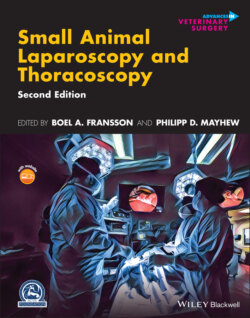Читать книгу Small Animal Laparoscopy and Thoracoscopy - Группа авторов - Страница 148
Insertion Technique of Standard Trocars for Single‐Port Entry
ОглавлениеSingle‐Port Access Technique (see Figure 6.2, Video 6.4).
A 1.5‐ to 2‐cm skin incision is made on the ventral midline in the region of the umbilicus. Using the Hasson abdominal access technique, a 5‐mm blunt laparoscopic low‐profile trocar–cannula assembly is inserted into the abdomen. The abdomen is insufflated using a pressure‐regulating mechanical insufflator to an intraabdominal pressure between 9 and 12 mmHg. After brief abdominal exploration with a 30° telescope, two additional very‐low‐profile 5‐mm trocar–cannula assemblies are then inserted in a triangular pattern adjacent to the initial port. For the second and third low‐profile trocar–cannula insertions, the abdomen is partially desufflated to approximately 6–8 mmHg to facilitate mobilization of the skin and soft tissue associated with the initial skin incision and to enable a small soft tissue flap to be created, which allows for tunneling of the ports adjacent to the initial trocar. Using minimal blunt dissection, a tunnel is undermined 1–2 cm laterally and caudally on either side of the initial 5‐mm trocar–cannula assembly using a Kelly hemostat. Through those tunneled paths, the two low‐profile trocar–cannula assemblies are inserted through the abdominal wall into the peritoneal cavity using the sharp trocars under optical visualization. The three trocars are arranged in a deliberate triangular arrangement that causes the skin to stretch in a lateral direction. This arrangement enables each low‐profile cannula to enter the abdomen through separate facial openings but enters through the same 2‐cm skin incision. Advantages with this entry method rely on the fact that existing standard metal and reusable trocar–cannula assemblies can be used, avoiding the cost associated with purchasing disposable equipment.
